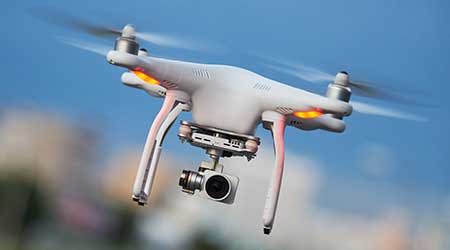
"It's Like Terminator!": How Hunter Drones Can Prevent Drone Attacks
September 23, 2019
Drones were a big draw at Global Security Exchange in Chicago recently. At one manufacturer’s display, a crowd gathered around a large enclosure where a drone demonstration was to take place. Except this would be drone versus drone, with the company’s drone slated to take down an adversary drone by disabling it with a net. “It’s like a Terminator!” said one bystander, as giddy as a 10-year-old boy.
Drones, or unmanned aerial vehicles, are taking to the skies in larger number. They can be outfitted with any combination of sensors and cameras, which makes them useful in gathering data in a dangerous situation, such as a wildfire. They can get to the scene of an incident more quickly than a first responder on foot or ground vehicle, and can provide two-way communication and help pinpoint the location of the incident. They can be used for routine surveillance of a larger perimeter, programmed to surveil a path and then return automatically to a home base. Those are just some of the life safety and security applications in use today. Their list of useful applications in commercial real estate goes on to roof maintenance, disaster documentation, and delivery of goods.
But that’s all when the drones are yours, doing your bidding. The same ability to take a host of sensors and cameras airborne means drones can present a threat to a facility in the wrong hands. Enter the hunter drone.
The idea is to control the airspace above a facility or campus. Detection systems use technologies like radar or radio frequency detection, or simply listen for the distinctive whine of rotors. Drones can then be intercepted if they are not allowed in your airspace. Certain technologies can take over control of a drone and bring it down. Or you can shoot a net at it with another drone.
I missed the actual takedown, but a tablemate at lunch filled me in on the details. The hunter drone whiffed two out of two attempts. A young member of the armed forces, he went on tell me that drones can be made silent and set on a preprogrammed path to avoid detection of control frequencies, so he was not overly swayed by the concept of drone detection. Another tablemate brought up a different concern: what happens when a disabled drone falls on a pedestrian’s head?
In other parts of the world, birds of prey have been dispatched as part of police forces to take down drones. YouTube has no shortage of eagle versus drone videos. However, some anti-drone raptor units have been disbanded due to their unreliable performance in the field.
What to make of it all? Well, it seems drones are going to become an ever more permanent presence in our skies. And also, heads up.
Naomi Millán is senior editor of Building Operating Management.
Next
Read next on FacilitiesNet












